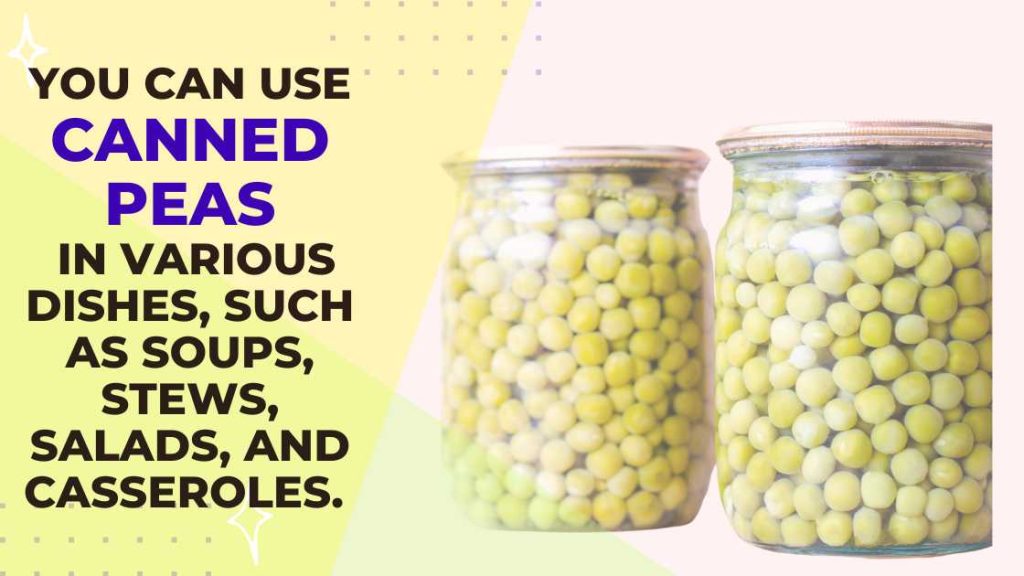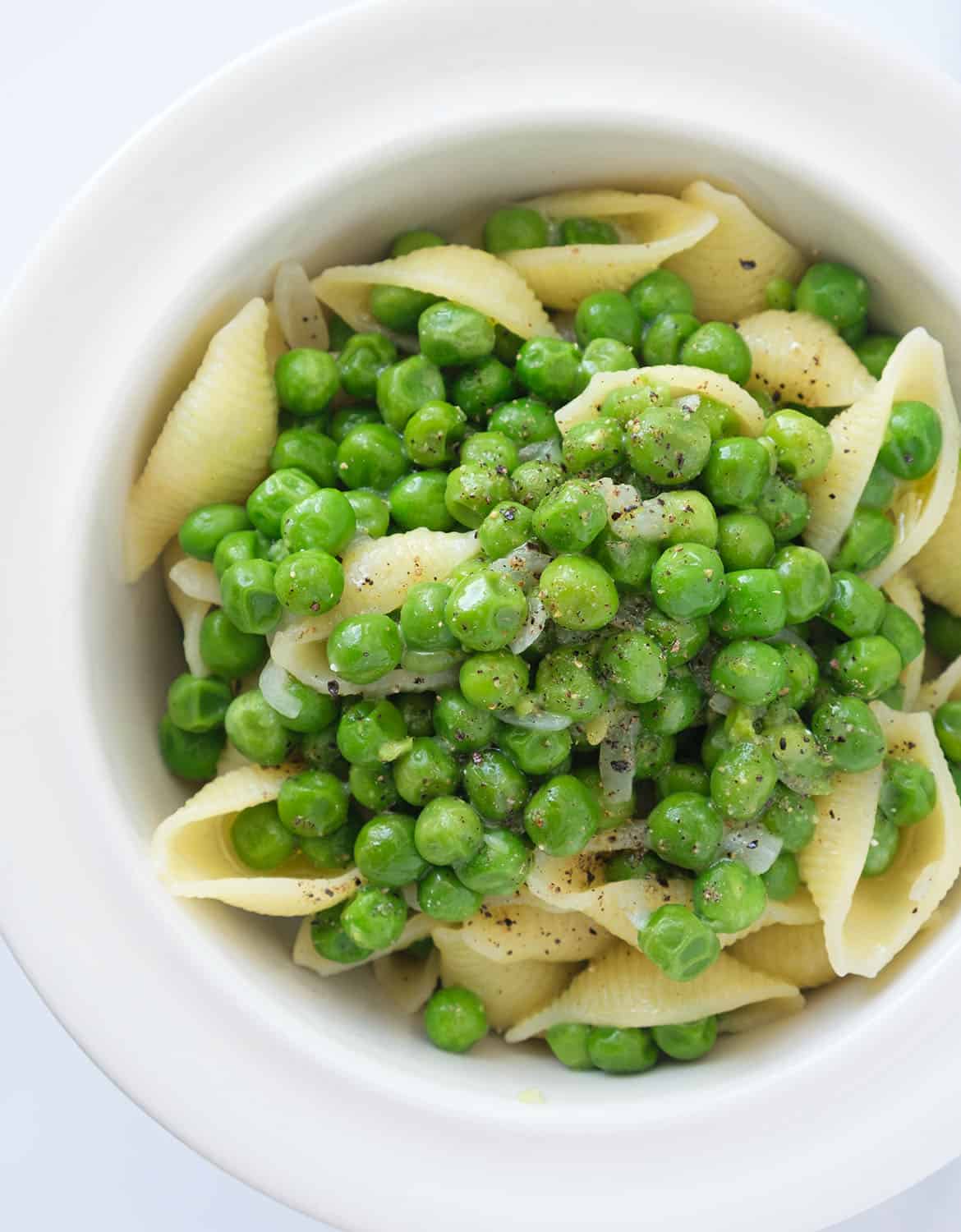Canned peas are incredibly versatile and can be used in various dishes, such as soups, stews, salads, and casseroles. Their mild flavor and tender texture make them an easy addition to almost any recipe, adding both color and nutrition.
You can use mushrooms in pasta, stir-fries, or stews to add flavor and nutrients. They also taste good in cold dishes, like a salad with peas and potatoes. Their slight sweetness helps to balance the manginess of the dressing.
Canned peas are great because they are pre-cooked and can be added to dishes easily. Simply drain and rinse them, and they’re ready to go. Canned vegetables have a long shelf life, so they are a reliable pantry staple when fresh produce is not available.

| Dish Type | Percentage of Recipes Using Canned Peas |
|---|---|
| Soups and Stews | 35% |
| Salads | 25% |
| Casseroles and Bakes | 20% |
| Stir-Fries and Sautés | 10% |
| Side Dishes | 10% |
Cook With Canned Peas
1. Pea Soup
- Ingredients: Canned peas, vegetable broth, onions, garlic, potatoes, carrots, and spices (like thyme or bay leaf).
- Instructions: Sauté onions and garlic, add diced potatoes and carrots, then pour in vegetable broth. Add canned peas and let it simmer until the vegetables are tender. Blend until smooth for a creamy soup.
2. Pea Salad
- Ingredients: Canned peas, diced onions, chopped boiled eggs, mayonnaise, mustard, salt, and pepper.
- Instructions: Mix all ingredients in a bowl. You can add other vegetables like celery or carrots for more crunch.
3. Peas and Pasta
- Ingredients: Canned peas, pasta (like penne or spaghetti), garlic, olive oil, parmesan cheese, and lemon zest.
- Instructions: Cook pasta, then sauté garlic in olive oil. Add canned peas, cooked pasta, and a bit of pasta water. Toss with parmesan cheese and lemon zest.

Credit: theclevermeal.com
4. Peas in a Stir-Fry
- Ingredients: Canned peas, mixed vegetables (like carrots, bell peppers), soy sauce, garlic, ginger, and your choice of protein (like chicken or tofu).
- Instructions: Stir-fry garlic and ginger, add vegetables and protein, then add canned peas at the end. Season with soy sauce.
5. Pea and Potato Curry
- Ingredients: Canned peas, potatoes, onions, garlic, curry powder, coconut milk, and tomatoes.
- Instructions: Sauté onions and garlic, add diced potatoes and curry powder. Pour in coconut milk and tomatoes, and simmer until potatoes are soft. Stir in canned peas at the end.
6. Peas and Rice Pilaf
- Ingredients: Canned peas, rice, onions, garlic, vegetable broth, and spices (like cumin or turmeric).
- Instructions: Sauté onions and garlic, add rice and spices, and pour in vegetable broth. Cook until rice is done, then stir in canned peas.
7. Peas and Mashed Potatoes
- Ingredients: Canned peas, potatoes, butter, milk, salt, and pepper.
- Instructions: Make mashed potatoes, then fold in canned peas for added texture and flavor.

Credit: www.gimmesomeoven.com
Benefits of Cooking with Canned Peas
Cooking with canned peas offers several benefits, making them a convenient and nutritious option for various dishes. Here are some of the key advantages:
- Convenience: Canned peas are pre-cooked, saving you time in the kitchen. They can be added directly to recipes without the need for soaking or cooking from scratch.
- Long Shelf Life: Canned peas have a long shelf life, making them a great pantry staple. You can keep them on hand for months or even years without worrying about spoilage.
- Nutritional Value: Canned peas retain most of their nutrients, including fiber, protein, vitamins (like A, C, and K), and minerals (like iron and potassium). They are a healthy addition to your meals.
- Cost-Effective: Canned peas are generally affordable, making them an economical choice for adding vegetables to your diet.
- Versatility: Canned peas can be used in a variety of dishes, from soups and stews to salads, casseroles, and side dishes. They can also be pureed into sauces or dips.
- Consistent Quality: Canned peas are harvested and processed at their peak ripeness, ensuring consistent quality and taste year-round, regardless of the season.
- Low Waste: Since canned peas are already cooked and ready to use, there’s minimal waste. You don’t need to discard any parts, and the liquid in the can can often be used in recipes.
- Portion Control: Canned peas come in various sizes, allowing you to choose the right amount for your needs. This helps with portion control and reduces food waste.
- Safe and Hygienic: The canning process involves heating, which kills bacteria and other pathogens, making canned peas a safe and hygienic option.
- Eco-Friendly: Cans are recyclable, and since canned peas are shelf-stable, they require less energy for storage compared to frozen or fresh peas.
12 Tips for Using Canned Peas
Using canned peas effectively can enhance the flavor and texture of your dishes. Here are some tips to get the most out of canned peas:
- Rinse and Drain: Although not always necessary, rinsing canned peas under cold water can help remove excess sodium and improve their flavor, especially if you’re watching your salt intake.
- Warm Gently: Since canned peas are already cooked, they only need to be warmed up. Heat them gently to avoid overcooking, which can make them mushy.
- Enhance Flavor: Boost the flavor of canned peas by cooking them with a little butter, garlic, onions, or herbs like mint, thyme, or parsley. A squeeze of lemon juice or a dash of vinegar can also brighten their flavor.
- Mix with Fresh Vegetables: Combine canned peas with fresh vegetables like carrots, bell peppers, or onions to add texture and freshness to your dishes.
- Add to Salads: Canned peas can be a great addition to salads, both cold and warm. They pair well with ingredients like hard-boiled eggs, cheese, bacon, and various dressings.
- Puree for Soups and Dips: Blend canned peas to create creamy soups or dips. They can be pureed with broth, cream, or yogurt and flavored with spices like cumin or curry for a smooth, rich texture.
- Use in Casseroles and Stews: Add canned peas to casseroles, stews, and pot pies. They add color, flavor, and nutrition, and since they’re already cooked, you can stir them in toward the end of cooking.
- Incorporate into Rice and Pasta Dishes: Stir canned peas into rice pilafs, risottos, or pasta dishes. They complement grains and pasta well, adding a sweet, earthy flavor.
- Thicken Sauces: Canned peas can be mashed and stirred into sauces and gravies to add thickness and richness.
- Avoid Overcooking: Since canned peas are already soft, avoid cooking them for too long, as this can make them mushy. Add them to dishes just before serving or in the last few minutes of cooking.
- Use the Liquid: The liquid from the can, often called aquafaba, can be used in soups or sauces for added flavor. However, be mindful that it may contain extra salt.
- Pair with Proteins: Canned peas go well with a variety of proteins like chicken, ham, beef, or tofu. They can be added to stir-fries, omelets, or mixed with ground meats for a balanced meal.
How Can I Use Canned Peas in Recipes?
Canned peas are versatile and can be used in various recipes without much preparation. Simply drain and rinse them to remove excess sodium and any canning liquids. They can be added directly to salads, soups, stews, or casseroles. You can also sauté them with butter, garlic, and herbs for a quick side dish. Their soft texture and mild flavor make them an excellent addition to pasta dishes or as a topping for rice and grain bowls.
Do I Need to Cook Canned Peas Before Eating?
Canned peas are already cooked during the canning process, so they are safe to eat straight from the can. If you prefer to warm them up, you can do so by heating them on the stove or in the microwave. Simply place the drained peas in a pot with a little water or butter and heat until warmed through. Alternatively, you can add them to hot dishes like soups or casseroles where they will warm up as the dish cooks.
How Long Do Canned Peas Last After Opening?
Once opened, canned peas should be transferred to an airtight container and stored in the refrigerator. They can last up to 3-4 days when stored properly. Be sure to check for any signs of spoilage, such as an off smell or slimy texture, before consuming leftovers. If you don’t plan to use them within this timeframe, consider freezing them to extend their shelf life.
Can I Freeze Canned Peas?
Yes, you can freeze canned peas to extend their shelf life. After opening the can, drain and rinse the peas, then spread them out on a baking sheet to freeze individually. Once frozen, transfer the peas to a freezer-safe bag or container. They can be stored in the freezer for up to 3 months. When you’re ready to use them, simply thaw the peas in the refrigerator or add them directly to your dish.
Are Canned Peas Nutritious?
Canned peas are a nutritious option, though they may contain slightly less vitamin C compared to fresh peas due to the canning process. However, they are still rich in fiber, protein, and essential vitamins such as vitamin A, vitamin K, and several B vitamins. They also provide a good source of minerals like iron, magnesium, and potassium. To reduce sodium intake, choose low-sodium varieties or rinse the peas before use.
How Can I Enhance the Flavor of Canned Peas?
To enhance the flavor of canned peas, consider adding seasonings or mixing them with other ingredients. A simple combination of butter, salt, and pepper can make them more flavorful. You can also add fresh herbs like parsley, dill, or mint for a burst of freshness. Sautéing peas with garlic, onions, or bacon can add depth to their flavor, making them a tasty side dish or ingredient in other recipes.
Can I Use Canned Peas in Baking?
While canned peas are not typically used in traditional baking, they can be creatively incorporated into certain baked dishes. For example, they can be mashed and added to savory muffins or scones for a unique twist. You might also find them in savory pie fillings or baked casseroles. When baking with canned peas, ensure they are well-drained and consider seasoning them to match the flavors of your dish.
How Do Canned Peas Compare to Frozen Peas?
Canned peas are cooked during the canning process, which gives them a softer texture compared to frozen peas. Frozen peas are often preferred for their fresher taste and firmer texture, as they are flash-frozen shortly after being harvested. Nutritionally, both options are similar, though frozen peas may retain slightly more nutrients, especially vitamin C. Choose between canned and frozen peas based on your recipe and texture preference.
Final Thought
Cannapeas are a versatile, convenient, and nutritious ingredient that can enhance a wide variety of dishes. With their long shelf life, cost-effectiveness, and ease of use, they make a valuable addition to any kitchen. By following simple tips like rinsing, warming gently, and combining with other fresh ingredients, you can maximize their flavor and texture, making them a go-to option for quick and healthy meals. Whether you’re adding them to soups, salads, casseroles, or simply enjoying them as a side dish, canned peas offer both practicality and taste, making them a staple worth keeping on hand.

I may be a little “crazy” when it comes to cooking, but I enjoy every minute of it. Spending time in the kitchen itself, whether with my family or my friends, brings me both happiness and exhilaration. This blog was created to showcase my cooking/eating with family and friends. And also as an opportunity to discuss ideas on food and the culinary circle in general.




